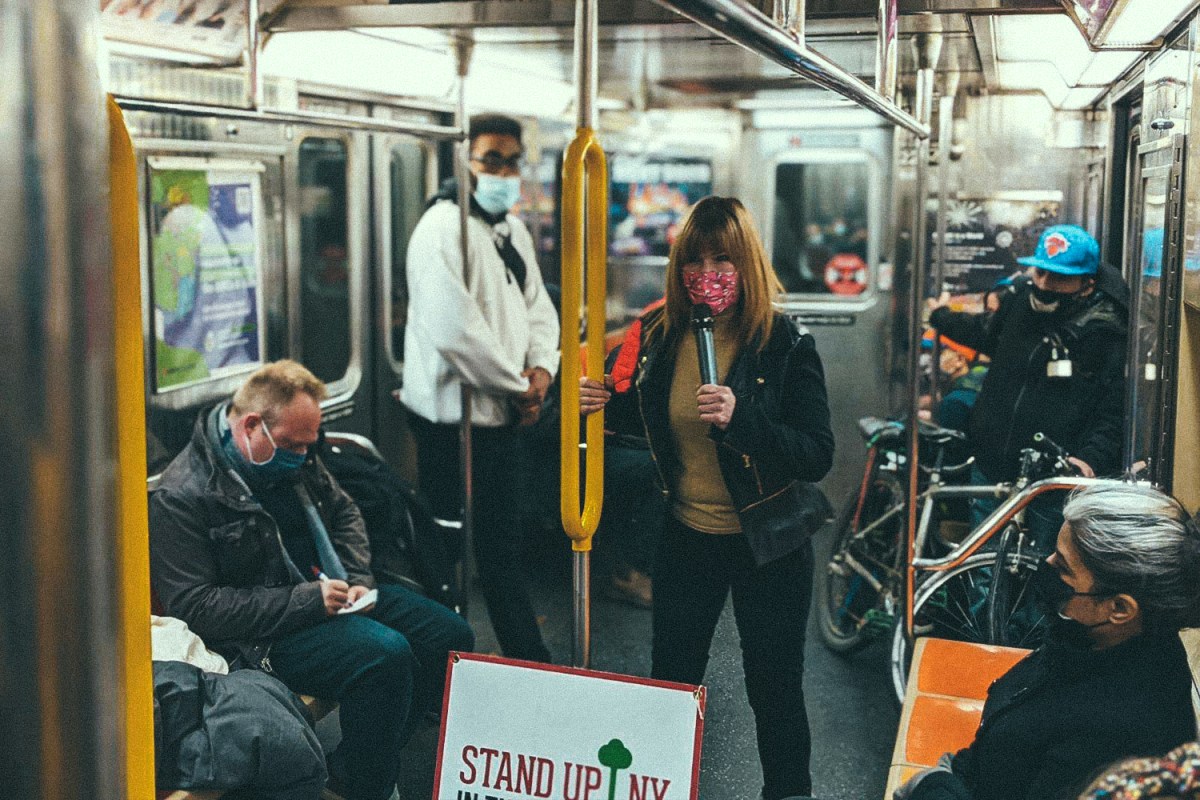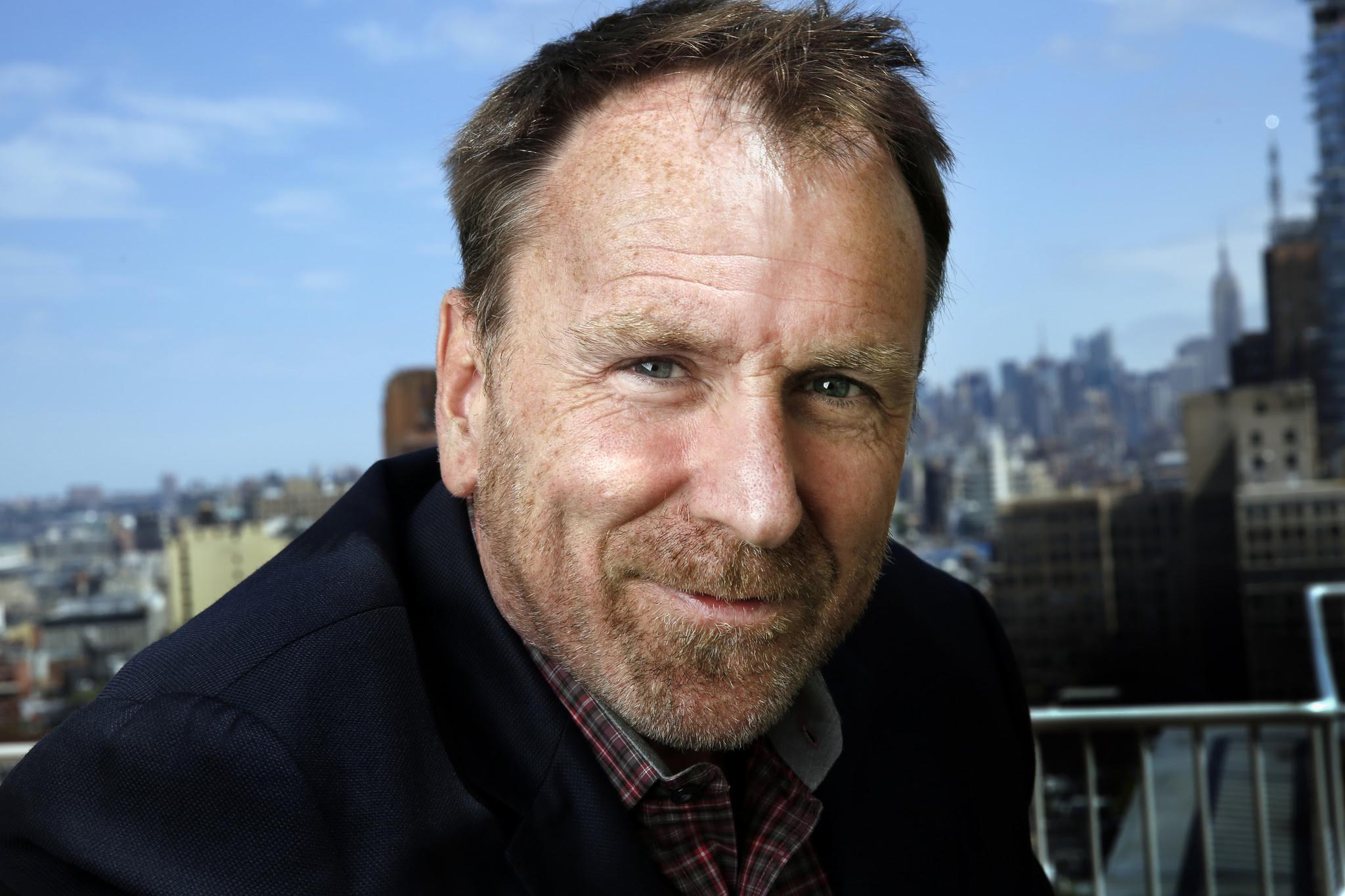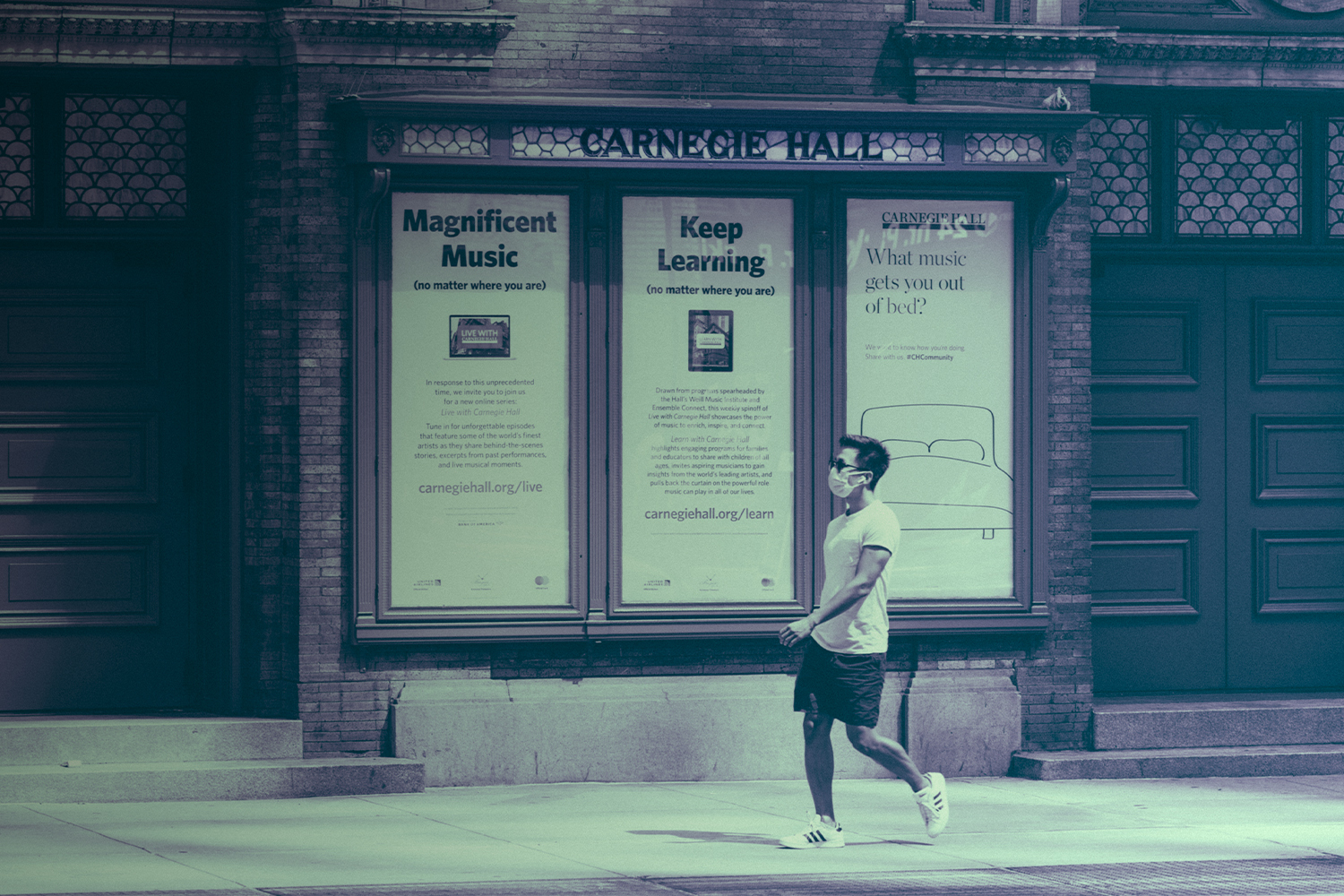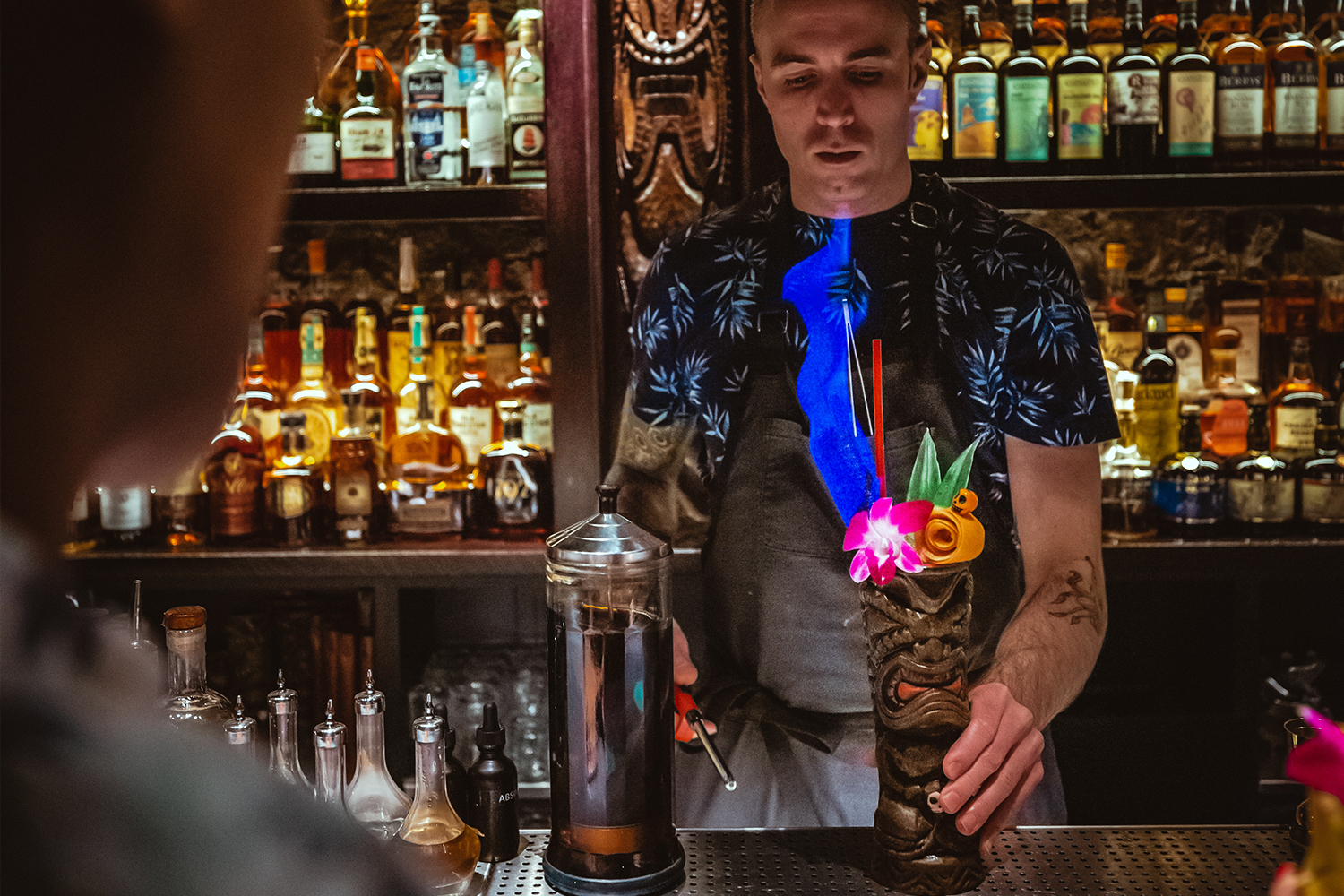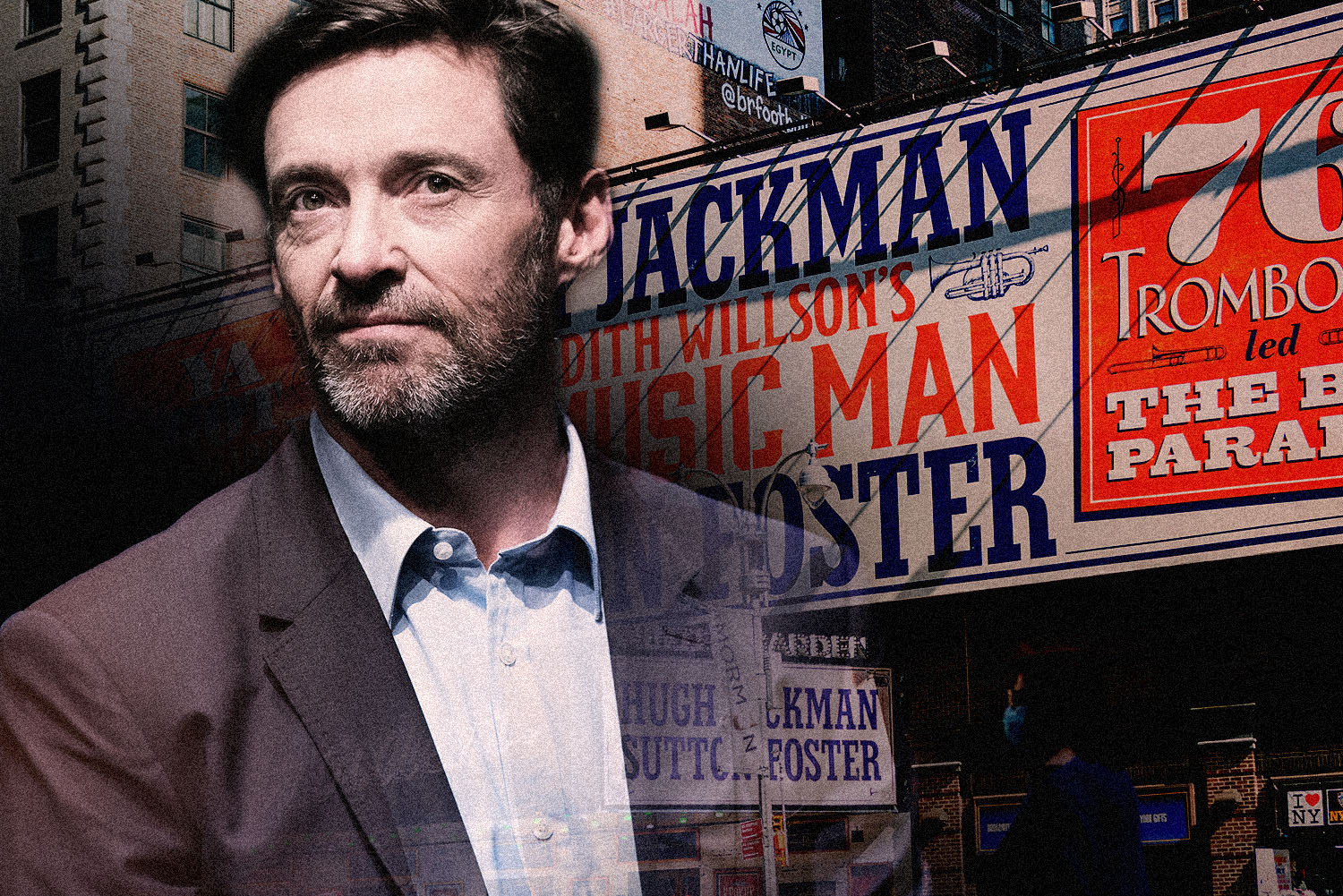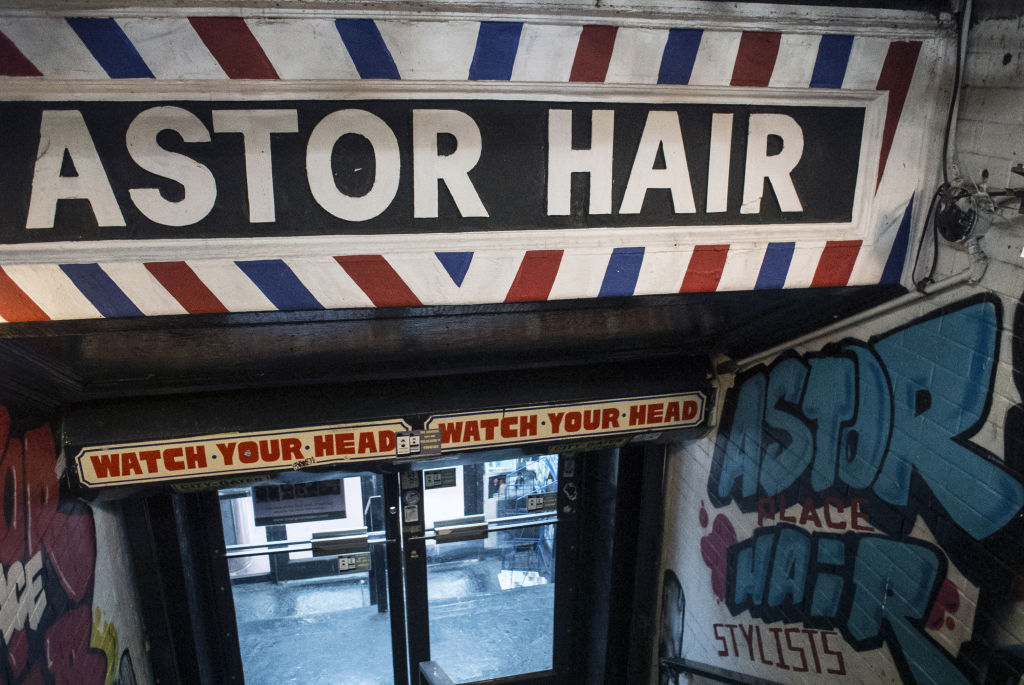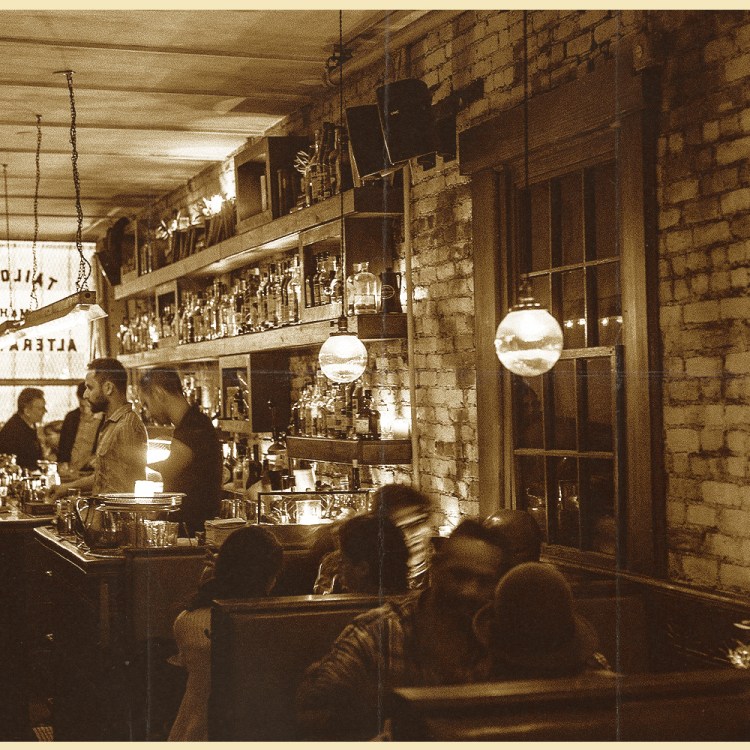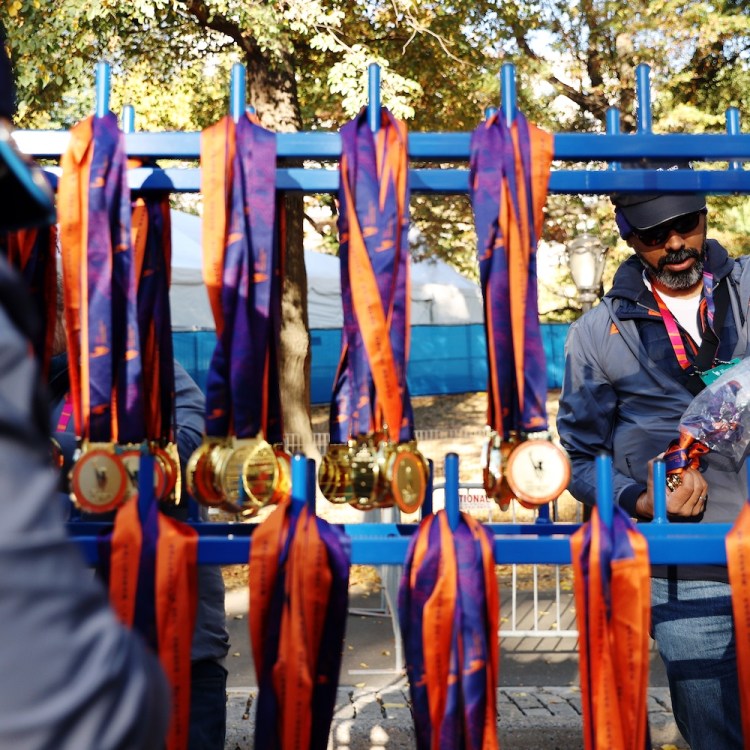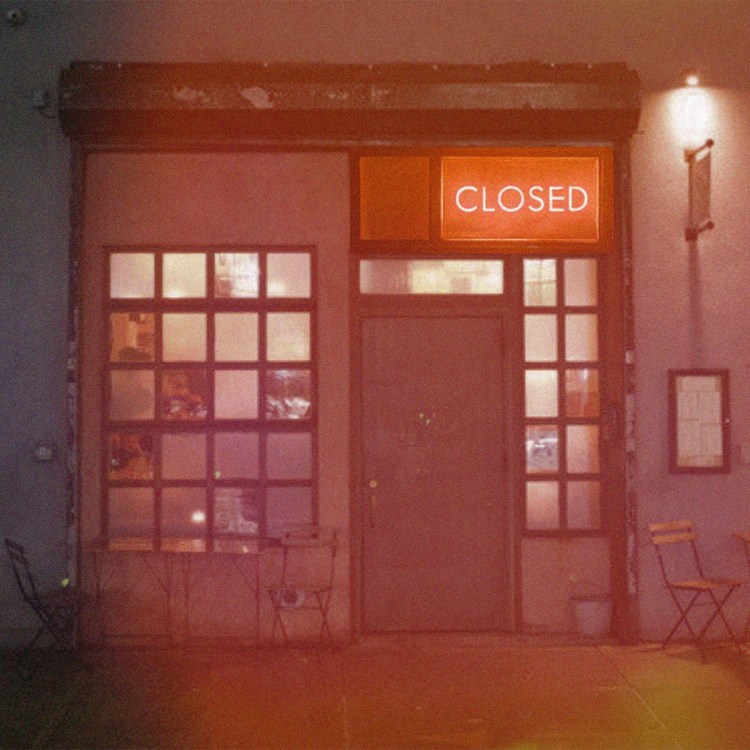In front of a small and, to this point, responsive audience, veteran stand-up comic James Mattern — his voice muffled by a face covering bedazzled with the outline of a Mexican wrestler mask — thanks the people for coming out. “You’ve obviously watched everything on Netflix,” he says.
After 11 months of social distancing in New York City, they’ve certainly had the time.
The crowd giggles, but after a few more minutes, Mattern’s struggling to hold their attention. He thinks he’s figured out why, though: “Punchlines don’t work when delivered right as the train leaves the station,” he announces.
Other challenges of performing stand-up in an active subway car include: maintaining balance when the train breaks, talking through conductor announcements and, as Mattern says, worrying that “the movie Warriors can break out anytime.” But these are the shows that Dani Zoldan, co-owner of the Stand Up NY comedy club, believes he must produce if he wants to keep his business from frosting over during the COVID-19 pandemic’s winter months.
“Where else can we do a show where it’s warm?” Zoldan tells me during an interview a few days before the performance.
His options, from a strictly weather-permitting point of view, were more plentiful between the late spring and early fall. With his club shut down due to legislated restrictions, Zoldan produced almost-daily performances in several city parks during those months. The gigs, which he says ultimately numbered about 500, generated revenue for Stand Up NY and paydays for financially strapped comics. Though New Yorkers legally took to the streets in sometimes unsafe droves to eat and drink outside restaurants and bars, Zoldan’s park shows remained technically against the law. Besides two Battery City shows that were broken up by the parks department, however, Zoldan tells me every performance went off without a hitch — or a confirmed case of COVID-19.
But as temperatures dipped to freezing and snowstorms took over weather forecasts, he had to literally take stand-up underground — i.e., into the subway system.
“It’s very New York; it’s very random,” Zoldan says of the experience. His audiences include paying, ticketed patrons as well as the unwitting ones who stumble upon a show after strolling into a randomly selected subway car. “You don’t know what you’re signing up for.”
Performances take place Saturday nights in the rear car of the number 1 train. Up to 15 paid attendees, six comedians, a show manager, Zoldan and his wife invade the 72nd street platform. Then, in Zoldan’s words, they “take over” the back of a downtown local.
“There’s no capacity restrictions on subways,” Zoldan observes. “You can go on the subway now and there will be, like, 50 people in there.”
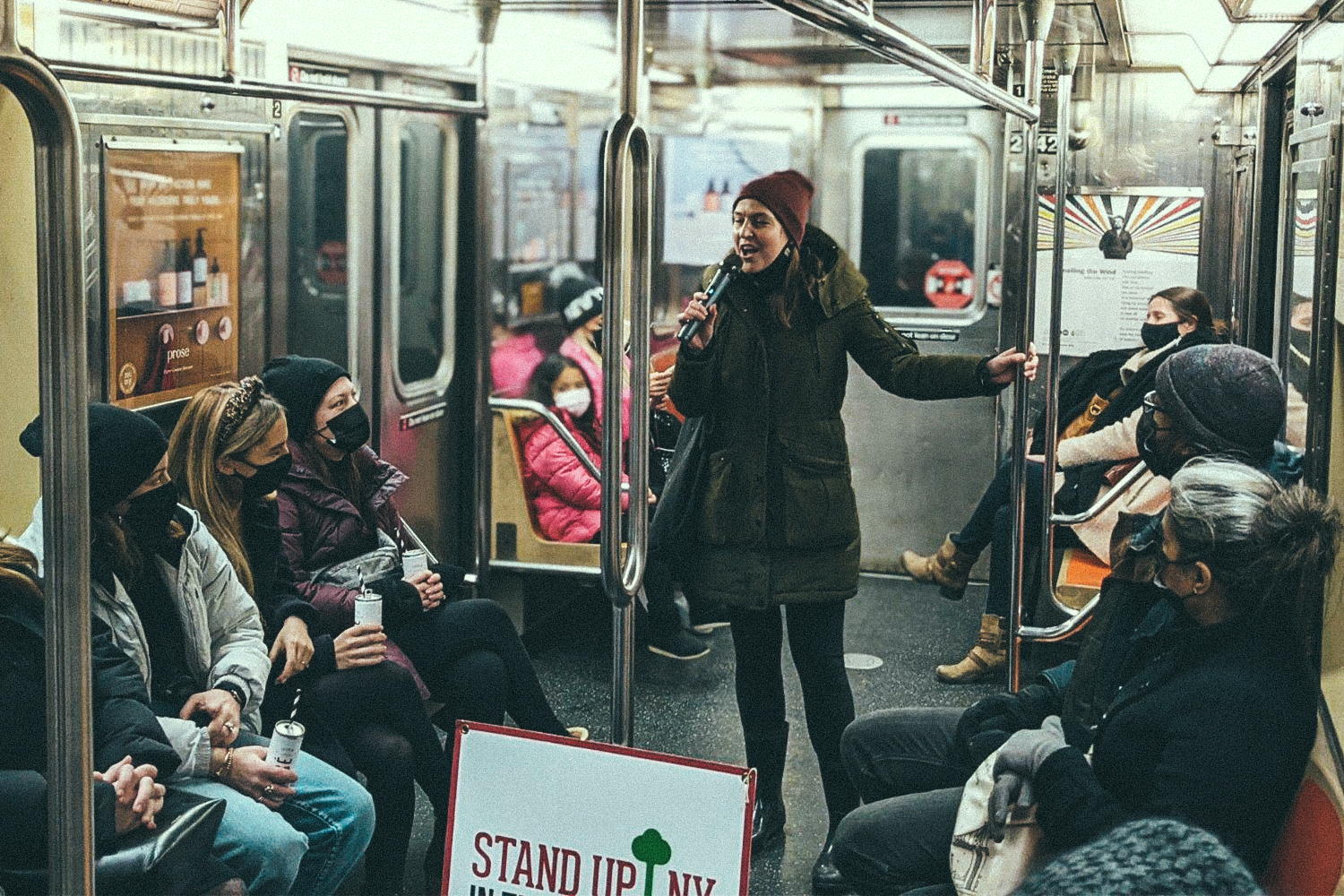
With a portable speaker providing voice amplification, comedians perform to a mostly seated, all-masked crowd spread out through the car. They ride the red line to its final stop at the Staten Island Ferry depot and then transfer to an uptown train. By the time everyone deboards again at 72nd street, they’ve enjoyed about an hour of comedy.
Zoldan says the red line is not heavily populated on Saturday nights, keeping the illicit pandemic shows safer. Tonight, during the February 6th gig, which includes two shows in neighboring cars, I immediately notice three riders already in the rear car at the time of the takeover. They soon move further to one end, away from the pop-up performance.
The performances boast about 20 attendees across the two cars, with comedians cycling between them. I, per laws of physics, can only be in one car at a time, but I still count at least a dozen more straphangers — who, on mic, Mattern calls “civilians” — entering and leaving the train during the gigs. On at least two occasions, nonplussed riders begin filming the show with their phones. One little boy, riding with his mother, leaves her side to sit in with the paid audience.
A three-person German TV news crew covering the shows with a camera and boom mic cramps the digs some more. And in celebration of Zoldan’s 40th birthday, the illegalities counter ticks up still further, as cans of rosé, sipped from paper straws by momentarily maskless faces, surface.
But at no point is there any hint of the show getting shut down. The comedians navigate a barrage of noise and distractions as best they can to fairly strong results.
While on mic at around Columbus Circle, one performer instructs two women — presumptive tourists who did not pay to see the show — how to get to their final destination of Jersey City. When we reach Penn Station, the tourists remain motionless until the comic shoos them off the car, telling them to go find the PATH train. After the doors close, he tells his audience, “No way they’re making it to Jersey City.” Everyone laughs.
Dr. Dean Blumberg, Chief of Pediatric Infectious Diseases at UC Davis Health, who I spoke to a day earlier, didn’t find much humor in the concept of subway stand-up, stating, “I’m not in favor of this at all.” He took particular exception to the fact that show attendees and performers remain in the subway cars together for an extended period of time, creating a potentially greater number of air transfers between them. Though I only catch one comedian taking her mask off for a brief moment the night I ride the train with them, Stand Up NY’s Instagram account has posted photos from previous subway shows with performers wearing their masks below their mouths. Blumberg told me he can understand why a comedian would eschew a face covering, “because your voice is muffled.” But, he added, “That’s making a compromise and it’s putting other people at risk as well as the performer.”
One female comedian who wished to remain anonymous tells me she has not responded to emailed calls for talent from the club for the subway shows because she doesn’t believe the health risks are worth it.
“The subway is a dangerous place during a pandemic,” she said. In her mind, the comedy performances “put a strain on the MTA workers” as well as other riders. “Everyone is supposed to be staying home” save for essential activities, she reminds me, and the subway shows are “encouraging people to ride the train” while “taking up another car where people could have been spreading out.” She’s grateful that Stand Up NY is providing comedians of various experience levels a place to perform, but ultimately, “Is it making it just a little bit harder for other people to be safe? Yeah, it is.”
“Obviously, not everyone feels comfortable with it,” Zoldan says of the unique gig, which, as far as he knows, has not led to any new coronavirus cases. “People that buy tickets and they come, it’s their choice. … There are some people who are against it, and they don’t have to come.”
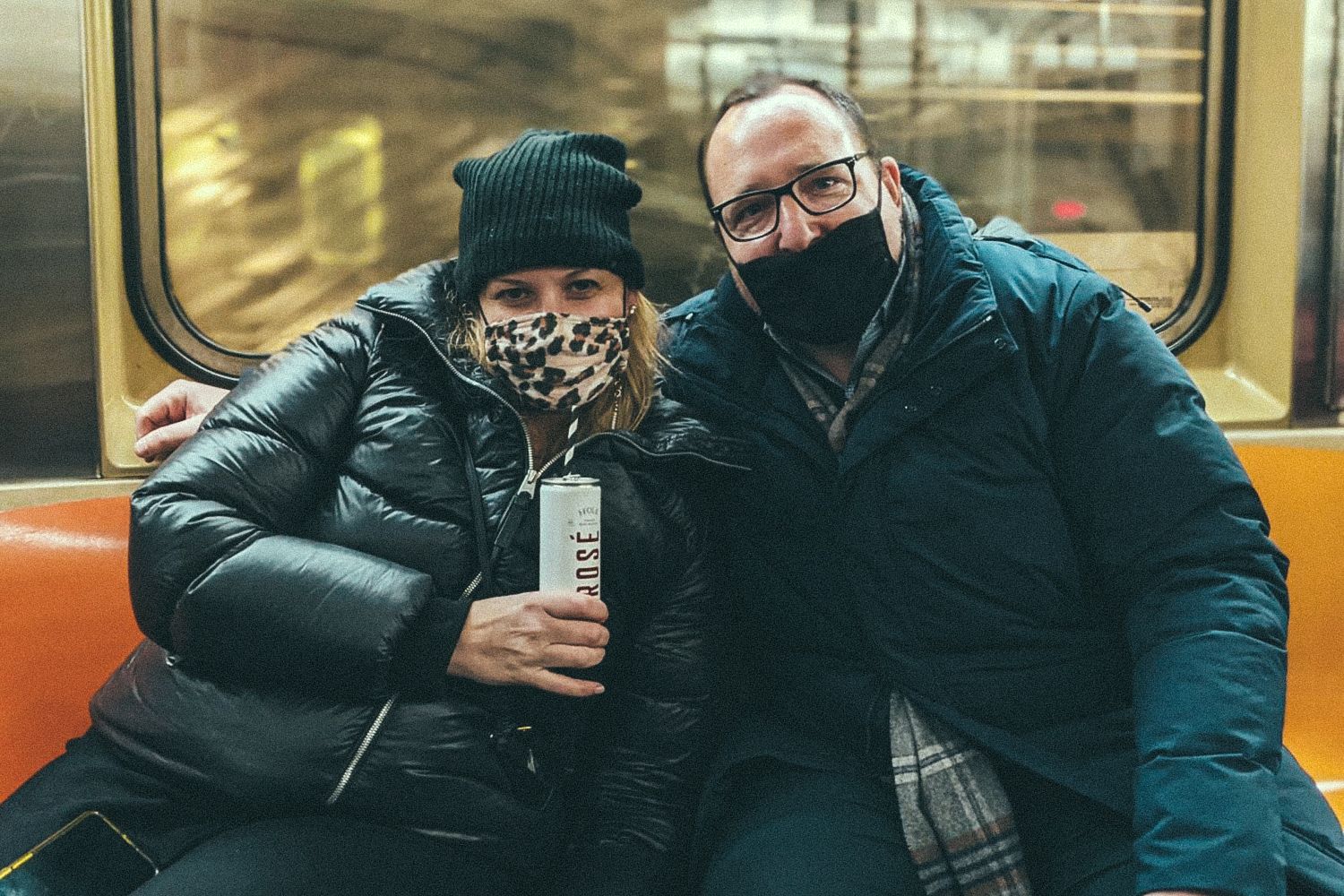
Thinking in the relative context of a subway show, Blumberg says perhaps a comedy performance in a large public transit hub like Grand Central Station, with higher ceilings, a larger volume of air and better ventilation, would be safer. I said to him that, to an extent, it sounded like he was also describing a comedy club.
“What’s important is that you look at the public health data, the contact tracing,” Blumberg responds. “That can inform policy decisions. So if public health is telling you that all these outbreaks are taking place in bars and restaurants, then they need to be closed, at least the indoor portion.” He says the reason many legislators have allowed barber shops to reopen for business during the pandemic, for example, is because data has indicated that getting a haircut is a low-risk activity. “These decisions should not be arbitrary and they should be informed by the data.”
But New York Governor Andrew Cuomo has never allowed comedy clubs to open during the pandemic, keeping health officials from collecting such data, and proving whether or not performances within them are low- or high-risk propositions.
“I can’t find a single person making these decisions who can explain to me why comedy clubs are any more dangerous than restaurants or bowling alleys that are allowed to operate right now,” said State Senator Michael Gianaris in a September interview with Vulture. He’d attended a rally in support of the #SaveNYComedy initiative, organized by club owners, sparked by Cuomo’s heavyhanded legislation. Gianaris added: “If the restaurants are allowed to have outdoor capacity, why is it any different that you have the same setup but with someone telling jokes? It makes no sense.”
“I don’t get the logic behind it,” Zoldan tells me, before adding that he supported the governor’s actions earlier in the pandemic. “Cuomo is just making it up as he goes along.”
In a September interview of his own, the governor said: “How essential is a comedy club when you’re talking about the infection rate? Not to offend people in the comedy club, Lord knows we need to laugh, but those are the calibrations we’re making.”
But since then, Cuomo may have taken a page out of Zoldan’s book. On Monday his office announced “NY PopsUp,” a series of 300 arts and culture events, including comedy performances, that will take place in New York City and across the rest of the state, starting February 20th. The venues? According to a press release, the performances will be held at “existing landscapes,” including “iconic transit stations, parks, subway platforms” and other public spaces.
“Instead of there being masses of audience members at a handful of events,” the press release reads, “this Festival is a mass of events, each for a safe and secure ‘handful’ of audience members.”
I text Zoldan about the announcement and he writes back, “So original!” Later, in an email, he adds, “We’ve been advocating for venues to be able to reopen under the same guidelines as restaurants and bars and we’ve been met with silence. … To add insult to injury, Governor Cuomo has announced that the city will be producing free indoor and outdoor pop up shows, again while ignoring the plight of venues desperate to reopen. The hypocrisy is just amazing.”
Politics aside, the comedians on Zoldan’s bill last Saturday were just happy to get some stage time. One of them, Vanessa Hollingshead, is 60 years old and has been a stand-up comedian for 29 years. In spite of her age, which puts her at a higher risk for complications from COVID-19, Hollingshead tells me prior to the gig, “I just have this faith that if you take good care of yourself and you practice social distancing, you’re going to be OK.”
She donned a mask throughout her set on the train, as did James Mattern, who before the show told me he was nervous about it, but not for safety reasons.
“There’s so many intangibles that can happen here,” Mattern says. Sticking with the wrestling theme, he adds: “This is like a Royal Rumble, dog.”
The wild nature of the shows only aided in their success as far as I, an apparent die hard comedy fan, am concerned. Though I was and still am anxious about having been in those train cars, I can’t deny having had a great time that night. It was the first instance since the cold air came to New York that I’d felt connected to a group of people, bound together with them, across our distance, by laughter.
When I arrived home, whether out of nervousness, joy, or both, I nearly wept.
This article was featured in the InsideHook NY newsletter. Sign up now for more from all five boroughs.
